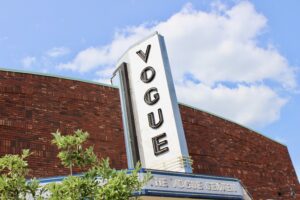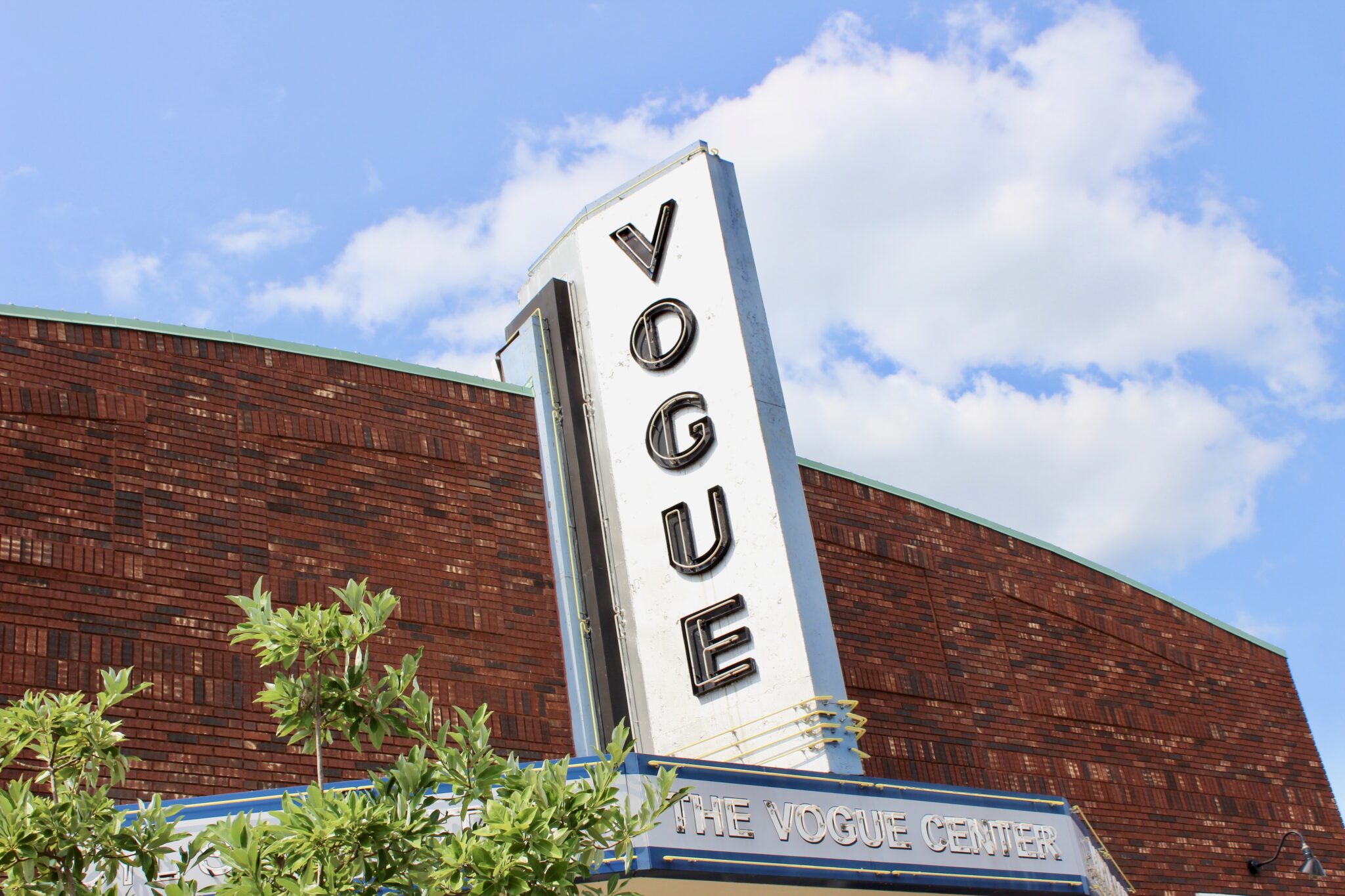A Look Back at Louisville’s Vogue Theater
Writer / Kevin Gibson
Photography Provided
While the building once occupied by the Vogue theater is now retail space, legions of Louisvillians remember it as a place that shaped their youth and even their cultural viewpoint.
In this city, the Vogue is essentially legendary, at least for a certain group. From full-blown live productions of “The Rocky Horror Picture Show” synced to the film itself, to the rotating midnight movies each weekend, to film festivals, those who ever went to the Vogue pretty much always went back to the Vogue. For many, it was not just once a month or every weekend, but a multiple-times-per-week proposition.
For some, it’s the first time they saw “Monty Python and the Holy Grail” or “A Clockwork Orange.” For others it was a place to see concert and rock films on the big screen, occasional classic silent films, as well as underground and foreign films that other theaters would never dare to show. Heck, Iggy Pop performed there.
As a regular at the Vogue myself during the 1980s and 1990s, some of my best memories are of seeing films like “The Warriors” on the big screen after having watched it for so long on the television in my parents’ basement. I remember seeing the bigger-than-life “Stop Making Sense” by Talking Heads there, and seeing films that freaked me out, such as “Liquid Sky.”
On many weekends, my friends and I, having no plans, would simply say, “Let’s just go to the Vogue.” Often, it didn’t matter what was on the screen; the atmosphere, along with a bucket of the theater’s delicious popcorn, was all we needed.
In fact, the theater created a sort of family of employees and regulars, an inner circle of sorts – one that wept when the projectors finally rolled for the final time and still mourns the loss two and a half decades later.
Early Life
While most remember it as the art-house theater cultivated by Marty Sussman and Carl Wohlschlegel starting in the late 1970s, the Vogue started its life as a neighborhood theater showing the first-run films of the day.
The theater opened in 1939 in a busy retail district. Vintage photos show it as part of a bustling corridor flanked by businesses like a Sears store, an F.W. Woolworth store, a supermarket and more. Those photos also show lines of families waiting to get inside. The theater’s first feature shown was “Lady of the Tropics,” starring Robert Taylor and Hedy Lamarr, and tickets cost 16 cents. The theater ads touted free parking and described the venue “the place to go.”
It quickly became a place for birthday parties and civic gatherings as well. In 1950 it played host to a cooking school for two days, and in 1953 it was a drop-off site for a book drive. It continued to host public meetings and showing movies through the 1960s. Things changed in the 1970s, when it began to transform into the place many would ultimately simply refer to as the Vogue, under new management with a bold, new vision.
For instance, in November of 1977 the theater played host to a Charlie Chaplin film festival – something most theaters would never even consider. In September of that year, Courier-Journal film writer Scott Hammen was already lauding the Vogue’s format change earlier in the year, extolling the “imaginative risks” Sussman was taking in programming. “Most theater owners considered the Vogue’s new format to be economic suicide, but, after a highly successful summer, the Vogue is surprising everyone,” Hammen wrote.
The Vogue, however, almost died an early death. In 1978, Taylor Drug Store, which owned the building, canceled Sussman’s lease, drawing an outcry from regular customers who called it a “disservice” to the community in letters to the editor of the Courier-Journal and labeled the closing – over a handful of the films that were screened there – “a cultural wound.” A petition circulated, the lease was ultimately renewed a few weeks later, and the new theater concept pushed on.
The Vogue was offered some stability in 1982 when the building was acquired by Henry Saag and his Associated Theatres of Kentucky. He retained Sussman as the curator and manager, and maintained the art-house format. Sussman told the Courier-Journal at the time, “If it works, don’t fix it. The Vogue works very well.” The Vogue became home to live theater, continued hosting community events and grew its fanbase organically, with alternative theater and cheap prices.
But Saag’s passing in April 1998 put the Vogue in jeopardy yet again. This time, the old theater couldn’t recover. It would close its doors for the final time, without warning, on September 17, 1998, and it was front-page news in the Courier-Journal. Dave Conover was there that night, and being an insider, although not an actual employee, he was in the know.
“The night the theater shut down was one of the saddest times I’ve ever experienced,” Conover says. “There was crying going on in every space as the final film rolled, and the audience inside had no idea they were going to be the last.”
Life After the Vogue
For Conover and the many like him who continue to mourn the Vogue, the place was more than just a movie theater.
“I was a little left of center and it was an amazing communal place to feel safe and different,” says Joe Botts, who frequented the theater in the 1980s and ‘90s. “I miss it terribly.”
Shannon Runke concurs, name-dropping films like “Dogs in Space,” “The Cure in Orange” and “The Moderns” as films she saw with friends at the Vogue. “The Vogue shaped my high-school-age experience in the late ’80s,” Runke says. “So many cinema experiences like these at the Vogue that informed our aesthetic and provided us with ideas to discuss.”
And specific memories are plentiful. Just ask Eddie Nedell. “One memory I have is being caught by the police with a bottle of vodka,” he says. “We were maybe juniors in high school so it was definitely not legal, and told to pour it out and go home and not come back. Needless to say, we parked my Cougar in some far-off alley and went to see ‘Rocky Horror Picture Show’ at midnight.”
Kevin DePaola remembers seeing “Return of the Living Dead” at the Vogue, which, as horror fans know, is set in Louisville, although it wasn’t filmed locally.
“My friend and I were unaware of the setting of the film, so halfway through the movie when the first Louisville police car showed up, we started to feel really uncomfortable,” DePaola says. “By the end, we waited until everyone left and slowly made our way to Lexington Road.”
And anyone who saw “Rocky Horror,” as Vogue veterans always referred to the film, remembers bigger-than-life costumes, bigger-than-life traditions (let’s just say if you “propose a toast” to a group of “Rocky Horror” fans, you’d better duck) and bigger-than-life energy. The whole place oozed alternative culture and community.
Conover ended up working at Baxter Theatre, which opened just before the Vogue’s demise and probably contributed to that demise on some level, for 12 years. Wohlschlegel went to work there for a time, and the “Rocky Horror” productions moved to Baxter. Having spent 17 years associated with the Vogue, however, Conover says at the time of its closing, he literally had spent half his life there. Baxter, for its strengths, could never replace it.
“The theater and its people changed my life, widened my world and altered my perceptions in every way,” Conover says. “It helped make me a whole person, and I’m sure so many folks have told similar stories. It was a place for misfits, the marginalized, the misunderstood, to find acceptance and just be, not only in its programming, but in its environment. It became, in a very literal sense, my sanctuary. It’s a cliche to use the term ‘I found my tribe there,’ but it’s the stone truth.”






Comments 1
I weep for a local cultural icon I never knew, and could never experience.